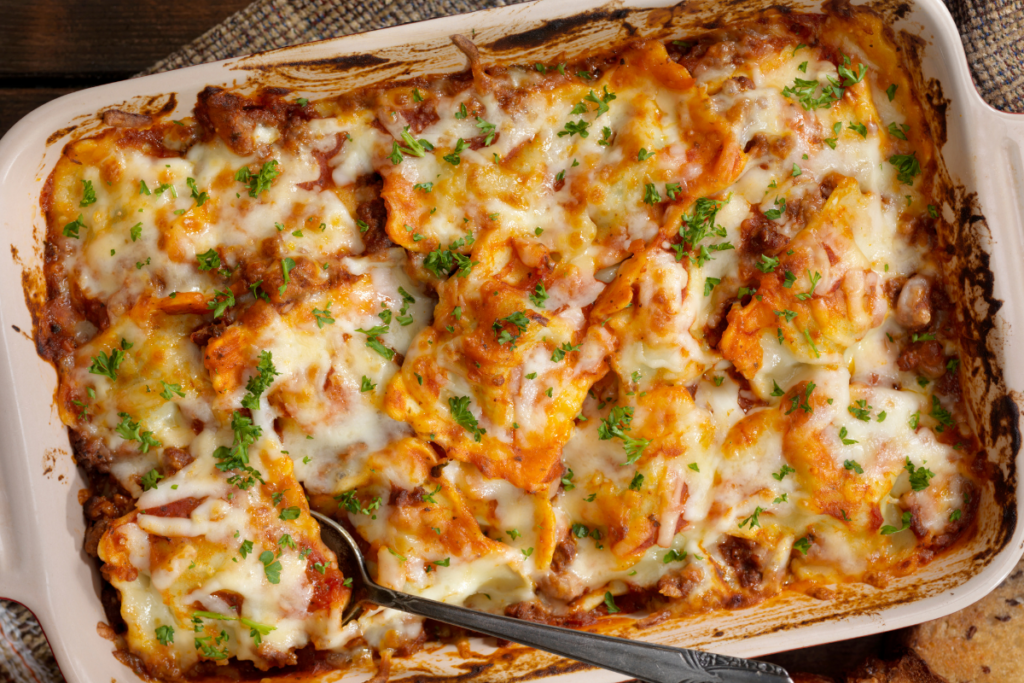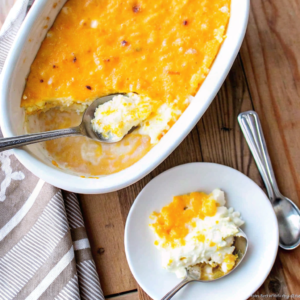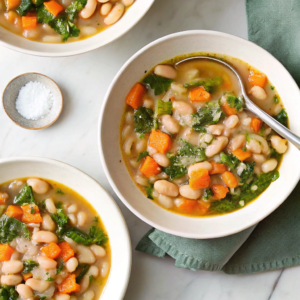When making ravioli, a classic Italian stuffed pasta, the preparation of the filling is key to achieving the perfect balance of flavor and texture. You might be wondering if you need to cook the meat before it becomes part of your ravioli masterpiece. It’s important to address this because using raw meat could pose health risks and affect the cooking time of your pasta.
Cooking meat before enclosing it in ravioli dough is a crucial step. Doing so ensures that the meat is cooked thoroughly, as the short boiling time for ravioli won’t necessarily be enough to cook the meat inside completely. Pre-cooking the meat gives you more control over the seasoning and ensures food safety. Moreover, it prevents the dough from getting soggy due to the release of juices from raw meat while cooking.
Understanding Ravioli
Ravioli is a traditional type of Italian pasta with a variety of fillings sealed between two layers of thin dough. It’s a dish enjoyed around the world and comes in countless variations.
History of Ravioli
The origins of ravioli are steeped in Italian history, with references dating back to the 14th century. Initially, ravioli was a food for special occasions, made with lavish fillings for the elite and simpler ones for the general populace. Over time, it has become a staple of Italian cuisine, with each region putting its unique twist on the classic.
Traditional Ravioli Fillings
Traditionally, ravioli fillings were made with what was available locally, which means they varied greatly between regions. Common fillings include:
- Cheeses such as ricotta or Parmigiano-Reggiano
- Meats like ground beef, pork, or chicken
- Vegetables such as spinach or the rich, savory filling of mushroom found in some Mushroom Ravioli recipes.
These ingredients were often mixed with eggs and spices before being enclosed in the pasta dough. Making ravioli at home allows for creativity and personalization of these time-honored fillings.
Preparation Basics
When making ravioli at home, it’s essential to prepare your meat properly and have the right tools on hand to ensure a delicious result.
Selecting Ingredients
In crafting your ravioli filling, it’s crucial to choose high-quality meat. Whether it’s beef, pork, or a vegetarian substitute, the meat should be cooked prior to being encased in pasta dough. This ensures that the filling is safe to eat and that the flavors have the opportunity to meld together properly. Ground meat is a common choice, and it can be seasoned with herbs and spices such as salt, pepper, garlic, and basil for additional flavor.
Essential Kitchen Tools
To make ravioli, you will need a few key kitchen tools:
- A large pot for boiling the ravioli
- Rolling pin or pasta machine for flattening the dough
- Ravioli cutter or a sharp knife to shape and seal the ravioli
For the filling, a skillet is required for cooking the meat. Additionally, having a mixing bowl on hand to combine the cooked meat with other ingredients like cheese and herbs will ensure a well-integrated filling. Lastly, consider the complementary elements of your meal, such as sauces or side dishes, which can enhance the overall dining experience. Discovering the perfect sauce and side pairings for your ravioli can turn a good meal into a delightful one.
Meat Filling Preparation
When making ravioli, it’s crucial to choose the right type of meat and determine whether to cook it beforehand. The preparation of the filling directly impacts flavor and texture, ensuring your dish is delicious and safe to enjoy.
Types of Meat for Ravioli
Different meats bring unique flavors to ravioli fillings. Common choices include:
- Beef: Rich and robust, offering a classic taste.
- Chicken: A leaner option that pairs well with creamier sauces.
- Lamb: Delivers a gamey punch, ideal for hearty fillings.
It’s important to select meat based on the final flavor profile you’re aiming for. If your recipe calls for a sauce, consider what meats will complement its taste.
Preparing Meat: Cooked vs. Raw
There’s a significant difference between starting with cooked meat versus raw meat when preparing ravioli fillings:
Cooked Meat:
- Ensures safety, as the heat has killed any bacteria.
- Provides a deeper flavor, as cooking develops taste.
- Has a drier, firmer texture, which can affect the moisture balance of your filling.
Raw Meat:
- Must rely on the cooking process of the ravioli to ensure it is done.
- Can retain more moisture, resulting in a juicier filling.
- Requires fine mincing to ensure even cooking inside the pasta.
For safety and consistency, cooking your meat before stuffing your ravioli is generally advisable. Not only does it prevent the risk of foodborne illnesses, but it also gives you more control over the texture and doneness of the meat.
Remember, when your ravioli are ready to be served, they can be elevated with the addition of a well-paired sauce. If you want to explore how to pair your ravioli with a sauce that enhances your dish, consider sauces that match the filling’s flavor complexity.
Assembling the Ravioli
When making ravioli, it’s crucial to prepare the pasta dough and meat filling correctly to ensure a delicious result. Cook the meat completely before encasing it within the dough to avoid any health risks.
Rolling the Pasta Dough
Your first step is to roll out your pasta dough. Aim for a consistent thickness to ensure even cooking later on. You can use a pasta machine or a rolling pin to get the dough to the desired thinness—typically about 1/16th of an inch. Dust with a little flour to prevent sticking.
Filling the Ravioli Pockets
Next, place small amounts of your pre-cooked meat filling on the dough sheets, spaced evenly apart. When doing this, remember not to overfill to prevent the ravioli from bursting when cooked. Wet the edges of the dough around the filling with a bit of water; this acts as glue to help seal the ravioli. Carefully lay a second sheet of dough over the first, and press down around the filling to eliminate air pockets and tightly seal. A ravioli cutter or knife can be used to cut out individual ravioli pockets.
For those looking for ways to elevate their ravioli’s taste, consider exploring various fillings and sauces that can add richness and complexity to your dish.
Cooking Techniques
When preparing ravioli, cooking the meat filling beforehand is essential for food safety and flavor. The ravioli itself should then be cooked through appropriate methods to ensure a delicious outcome.
Boiling Ravioli
Boiling is the most traditional method for cooking ravioli. Begin by bringing a large pot of salted water to a rolling boil. Carefully add your ravioli to the pot and cook for about 4 to 6 minutes or until they float to the top, signaling they’re ready. It’s crucial to not overcrowd the pot to prevent the ravioli from sticking together.
- Bring Water to Boil:
- Quantity of water: Ample to cover ravioli
- Salt: As per taste (usually a teaspoon for a large pot)
- Cook Ravioli:
- Duration: 4-6 minutes
- Indication of doneness: Ravioli floats to the surface
Sautéing or Baking
Sautéing or baking your ravioli after boiling can add an extra dimension of texture and flavor. If you choose to sauté, heat a bit of oil or butter in a pan over medium heat, then add the boiled ravioli, tossing gently until they are lightly golden. For baking, preheat your oven, arrange the boiled ravioli in a single layer on a baking sheet, and bake until they are crisp to your liking.
- Sauté:
- Heat source: Medium
- Fat: Oil or butter
- Duration: Until golden
- Bake:
- Oven Temperature: 375°F (190°C)
- Arrangement: Single layer on baking sheet
- Duration: Until desired crispiness
Serving and Pairings
When your ravioli is perfectly stuffed and cooked, the right sauce and presentation will enhance your dining experience further.
Choosing a Sauce
Your choice of sauce can transform your ravioli dish. For meat-filled ravioli, a classic tomato-based marinara complements the rich flavors. Alternatively, brown butter sage sauce adds a nutty and aromatic profile that’s exceptionally comforting. For creamy pairings, a simple alfredo sauce or a béchamel with a touch of nutmeg will envelop the ravioli in a velvety coat.
Garnishing and Presentation
Once sauced, the presentation of ravioli can be elevated with thoughtful garnishes. Grated Parmesan or Pecorino Romano adds a salty, umami kick, especially when used sparingly over hot ravioli. Fresh herbs like chopped parsley or basil leaves add color and freshness to your plate. For an earthy component, sautéed Baby Bella mushrooms can be an excellent topping, especially knowing the nuances between them and their mature counterpart, Portabella, which can affect the dish’s flavor profile. A final drizzle of high-quality olive oil can round out the dish with a rich mouthfeel and satisfying finish.
Frequently Asked Questions
For ravioli filling, meat should be cooked before stuffing to ensure it is safe to consume and to allow for proper seasoning. Cooking it separately also allows the meat to achieve a finer consistency, making it better suited for ravioli filling.
Boil the ravioli in salted water for 4-6 minutes, depending on the dough’s thickness. Meat-filled ravioli are done when they float to the water’s surface and the dough becomes tender.
Using raw meat in ravioli is not safe as the short cooking time of the pasta is insufficient to cook the meat inside fully. Always cook meat thoroughly before encasing it in ravioli to eliminate any harmful bacteria.
Traditional Italian ravioli are often filled with a mixture of meats such as beef, pork, and veal, sometimes combined with vegetables like spinach or mushrooms, such as the flavorful Baby Bella mushrooms.
An easy meat filling for ravioli includes ground beef or pork, cooked until brown and seasoned with salt, pepper, garlic, and herbs like parsley. Let it cool before blending with grated cheese and egg to bind the mixture for your ravioli.
By pre-cooking the meat before adding it to your ravioli filling, you can ensure it has reached a safe internal temperature. You can also use a meat thermometer to check for doneness.



